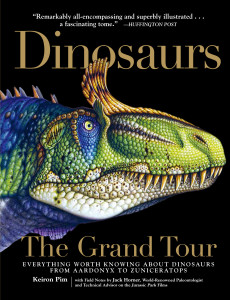
This guest blog post comes from Keiron Pim, author of Dinosaurs: The Grand Tour, and lifelong dino enthusiast.
No one went to see Jaws for a lesson in marine biology, and I don’t suppose many serious ornithologists exercised themselves over Alfred Hitchcock’s unfair portrayal of avian-kind in The Birds.
So to go and see a Hollywood blockbuster about man-eating dinosaurs and complain about its lack of palaeontological accuracy is to miss the point in some style. Jurassic World, which opened this weekend to global record takings, was never likely to act as a showcase for the very latest vision of the Mesozoic era. You might as well point out that most of the dinosaurs featured–Tyrannosaurus, Velociraptor and Ankylosaurus to name a few–are from the Cretaceous period rather than the Jurassic. What matters to film directors and most cinemagoers alike is telling the most gripping story possible, and wherever there’s a conflict between that and the facts, there will only ever be one winner.
Still, from a palaeontologist’s point of view you can see why it would be frustrating. For one, I’m sure that they’d argue the truth is actually far more interesting, and I’m with them on that. Now, I hugely enjoyed Jurassic World as a piece of entertainment, and even if it was sufficiently formulaic that you could guess with 100% accuracy which characters would end up clamped between a theropod’s gigantic jaws, it was great fun being taken along for the ride.
However, even if your priority is thrilling your audiences ahead of educating them, in director Colin Trevorrow’s case, opting for a little more realism could have increased the thrills by making the dinosaurs even scarier. On the one hand, the film’s concept has been brought right up to date, with the old Jurassic Park becoming a vividly imagined complex containing a Seaworld-style aquarium containing an immense Mosasaurus (too immense for some experts’ tastes, they were in reality around half this size at up to 18m long, but again I refer you to my point above), great sauropod-populated plains through which visitors can roll in a (supposedly) dino-proof glass ball, and hologrammatic ‘raptors’ inhabiting the visitor center.
 But to anyone who has read a book or watched a documentary about dinosaurs in the past decade–which is to say a fair share of the world’s population–amid all this brilliantly realized context the stars of the show will look a touch old-fashioned. This in turn lends them a quaint quality that undermines the fear factor. It’s probably absurd even to talk about believability with regard to Jurassic World, but the premise would be more believable–and thus more chilling–if the dinosaurs appeared how we currently believe them to have appeared. Instead they’re more reminiscent of the scaly Godzilla-type monsters of old than of the frighteningly strange, birdlike, vibrantly colored feathered beasts that populate the pages of recent books (such as my Dinosaurs: the Grand Tour).
But to anyone who has read a book or watched a documentary about dinosaurs in the past decade–which is to say a fair share of the world’s population–amid all this brilliantly realized context the stars of the show will look a touch old-fashioned. This in turn lends them a quaint quality that undermines the fear factor. It’s probably absurd even to talk about believability with regard to Jurassic World, but the premise would be more believable–and thus more chilling–if the dinosaurs appeared how we currently believe them to have appeared. Instead they’re more reminiscent of the scaly Godzilla-type monsters of old than of the frighteningly strange, birdlike, vibrantly colored feathered beasts that populate the pages of recent books (such as my Dinosaurs: the Grand Tour).
There is, however, one way in which the science behind Jurassic World is starting to seem more realistic now than was once the case. Its main premise is that, under pressure to boost visitor numbers, the attraction’s laboratory scientists have concocted a genetically modified hybrid dinosaur that they have named Indominus rex. This gargantuan beast combines genes from cuttlefish (allowing it to change color for camouflage), treefrogs (for thermal regulation), Tyrannosaurus and another dinosaur, which to describe further would give away part of the story. And according to the prominent American palaeontologist Jack Horner, who served as Spielberg’s technical adviser and contributed a section in my book describing where to track down dinosaur history in the USA, there is indeed the possibility of a strange sort of pseudo-dinosaur being created this way.
This project arose out of a failed bid to see whether some remnants of what has been claimed to be genuine T. rex soft tissue would yield DNA. Horner and his colleagues started by accepting that there is no chance of resurrecting a single dinosaur’s complete DNA sequence, as it begins to degrade within thousands of years, and the last non-avian dinosaurs died out around 65 million years ago. One useful way of looking at this is to liken an animal’s DNA profile to a novel of, say, 300 pages. Even if palaeontologists managed to extract 99 per cent of a dinosaur’s DNA, they would be left reading a book which had three pages ripped out, and would have to deduce the remainder of the story by guessing all the words and placing them in precisely the right order. In other words, it’s impossible.
But genetic manipulation is not impossible. In fact, Professor Horner and colleagues have been working on just such a project over the past five years. Given that resurrecting a Mesozoic dinosaur seems a non-starter, instead they decided to focus on manipulating the dinosaurs that live around us today: also known as birds. When he was growing up in Montana, Professor Horner had two wishes: to be a palaeontologist and to have a pet dinosaur, and having achieved the first of these he’s trying to make the second a reality, as well. In 2009 he and his colleagues announced their intention to create a ‘Chickenosaurus’, and after years of silence they announced in November that they were making some progress.
In general terms, to bring out birds’ hidden ancestral characteristics and reactivate the dinosaur within, there are three techniques at scientists’ disposal.
One is selection: just as centuries of work by dog-breeders turned wolves into Chihuahuas, and horticulturalists select the most beautiful roses to develop new hybrids, they know that by mating individual birds in which they have already stimulated latent dinosaur features, these features will be even stronger in the birds’ offspring.
The second method is transgenesis, the transplanting of genes from one organism into another. There are plenty of precedents for this, from genetically modified crops to ‘knockout mice.’ In the last 20 years scientists have bred thousands of varieties of these mice to research treatments for human diseases. They’re so-called because each strain has a different gene removed or ‘knocked out’ and replaced with another. For instance, one has a gene that inhibits the replication of tumour cells, which could help tackle cancer.
Related to this, the third technique is termed ‘atavism activation’. Atavistic characteristics are ones that belonged to animals’ ancient ancestors and are retained in a very faint form–but that occasionally pop up again and manifest themselves as fully developed features. Horner gives a couple of examples: for one, all humans have a tailbone, known as a coccyx, but very rarely babies are born with a tail. (Yes, really. Recent cases have been reported in India and China, and the technical term is a ‘caudal appendage’.) Snakes are another example: long ago they evolved to lose their legs, but their skeletons reveal tiny spurs of bone where you would expect the limbs to be–and sometimes snakes are actually born with these legs developed.
Horner’s ‘reverse engineering’ project rests on the fact that birds have some strange vestigial throwbacks as well. A chicken embryo has a tail, a gene that can cause teeth to grow in its beak, and three long finger-bones that form hands very similar to those of the primitive bird Archaeopteryx (which lived 147 million years ago) and the feathered dinosaur Velociraptor, which lived 75 million years ago (and which incidentally was a feathery little hunter the size of a turkey rather than the big scaly creature depicted in Jurassic World). But by the time the chick hatches, genes have kicked into action to make the tail recede to a stub, prevent the teeth from emerging, and fuse the handbones together into a wing.
If these genes can be identified, then they can be removed. And if they can be removed, then there should be nothing to stop a chicken being born with a tail, teeth and clawed hands: in other words, a ‘Chickenosaurus’.
Detractors point out that Professor Horner’s project, which will take years of gradual genetic tinkering, would not recreate an extinct genus of dinosaur. And naturally, though perhaps irrationally, there are those who fear the possible consequences of creating new dinosaurs. It’s a long step, however, from creating a ‘Chickenosaurus’ to Indominus rex.
But quite aside from the curiosity value, those involved are convinced of the project’s scientific worth. His colleague Hans Larsson at McGill University has said: “It’s a demonstration of evolution. If I can demonstrate clearly that the potential for dinosaur anatomical development exists in birds, then it again proves that birds are direct descendants of dinosaurs.”
If they ever achieve this then surely they would succeed where even Jurassic World has failed and achieve the rare feat of thrilling and fascinating both scientists and the general public alike.




